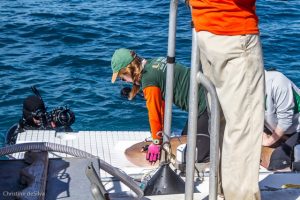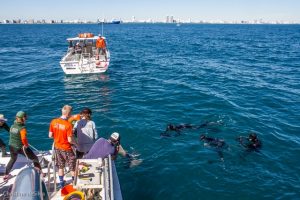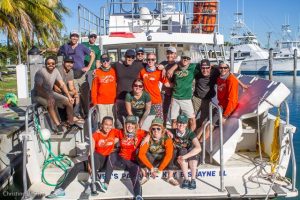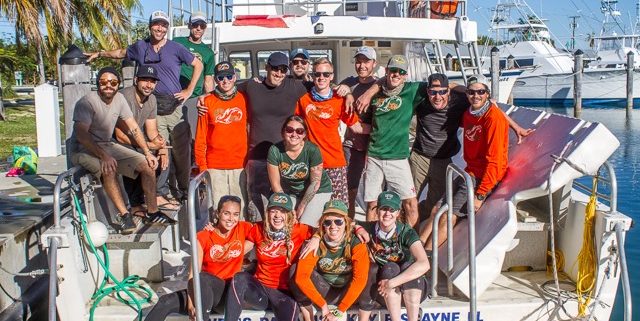Shark Tagging with National Geographic
By Rachel Skubel, SRC Intern
This was our third and final day with the National Geographic film crew. By now, the Nat Geo team was familiar with how our research team operated; I can’t say enough about how fantastic they were to work with. After yesterday’s great hammerhead/bull/lemon/nurse shark progression, we were all optimistic about the day’s outcome.
Captain Eric set a course for Sandbar Palace, a few miles off of Key Biscayne. The depth was up to 100 feet, which meant we were able to deploy our longer drumline setups – and also that chances were good for encountering larger bodies pelagic species! Excitement grew with taking environmental measurements – water temperature was 24°C, certainly warm enough for great hammerheads!
As we pulled in the first set of 10 drumlines, our first animal of the day was to be an energetic nurse shark (GInglyostomo cirratum). We got a tonne of great data from this animal, including a series of morphological measurements, whole blood and plasma samples, and thermal imaging.

The UM shark research team working up a nurse shark
A few minutes later, as graduate student Jake Jerome was pulling in a drum, our director Neil Hammerschlag noticed the line scoping out – a possible sing of a great hammerhead, as they swim near the surface! Indeed, a beautiful Sphyrna mokarran was brought onto our platform, and was a perfect candidate for a satellite tag. We were even able to take a valuable blood sample, to be used for hormone, energetic, and genetic analyses among others. The amount we can learn from one animal is just astounding, and given their status as endangered, this is critical information for uncovering effective conservation regulation. The satellite tag will let us know where animals of this species migrate to, which (for example) informs policies regarding habitat protection.

Pulling in a great hammerhead shark, before a swift work-up by our team – including the attachment of a satellite tag!
After releasing this animal back into the water, and watching it swim away in good condition, we were thrilled about what we had caught so far. The day was far from over, as we lucky enough to capture another individual of each species (nurse and great hammerhead) for a total of four sharks! We felt fantastic about all the data we captured these past three days, and are eager to work this into the ongoing projects of the Shark Research and Conservation group. Stay tuned for some exciting publications!

The hardworking research and film teams after our three-day #sharkfest
If you’d like to follow the journey of the great hammerhead shark we tagged today, we will be releasing a link as soon as we get transmissions!




Leave a Reply
Want to join the discussion?Feel free to contribute!